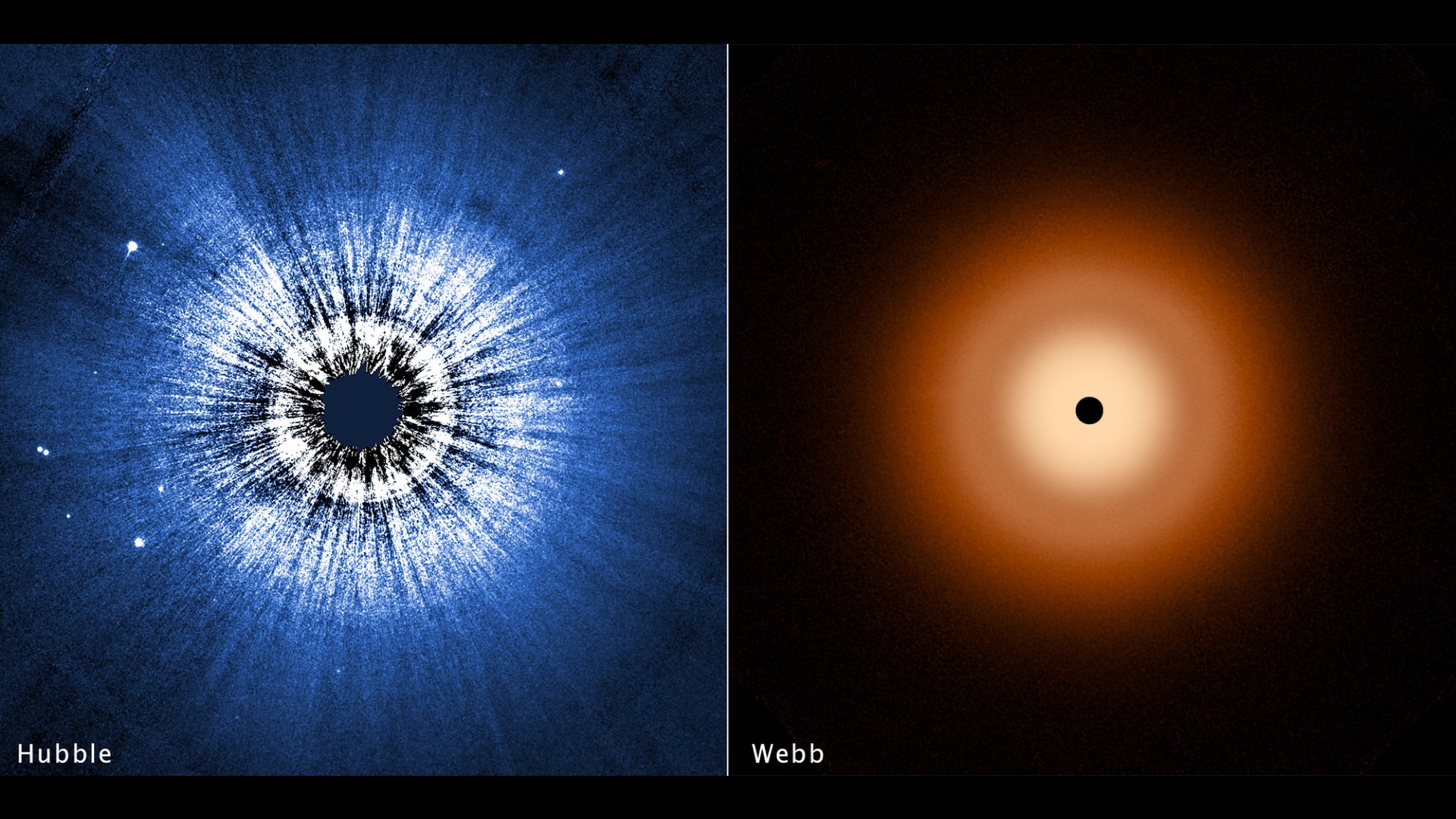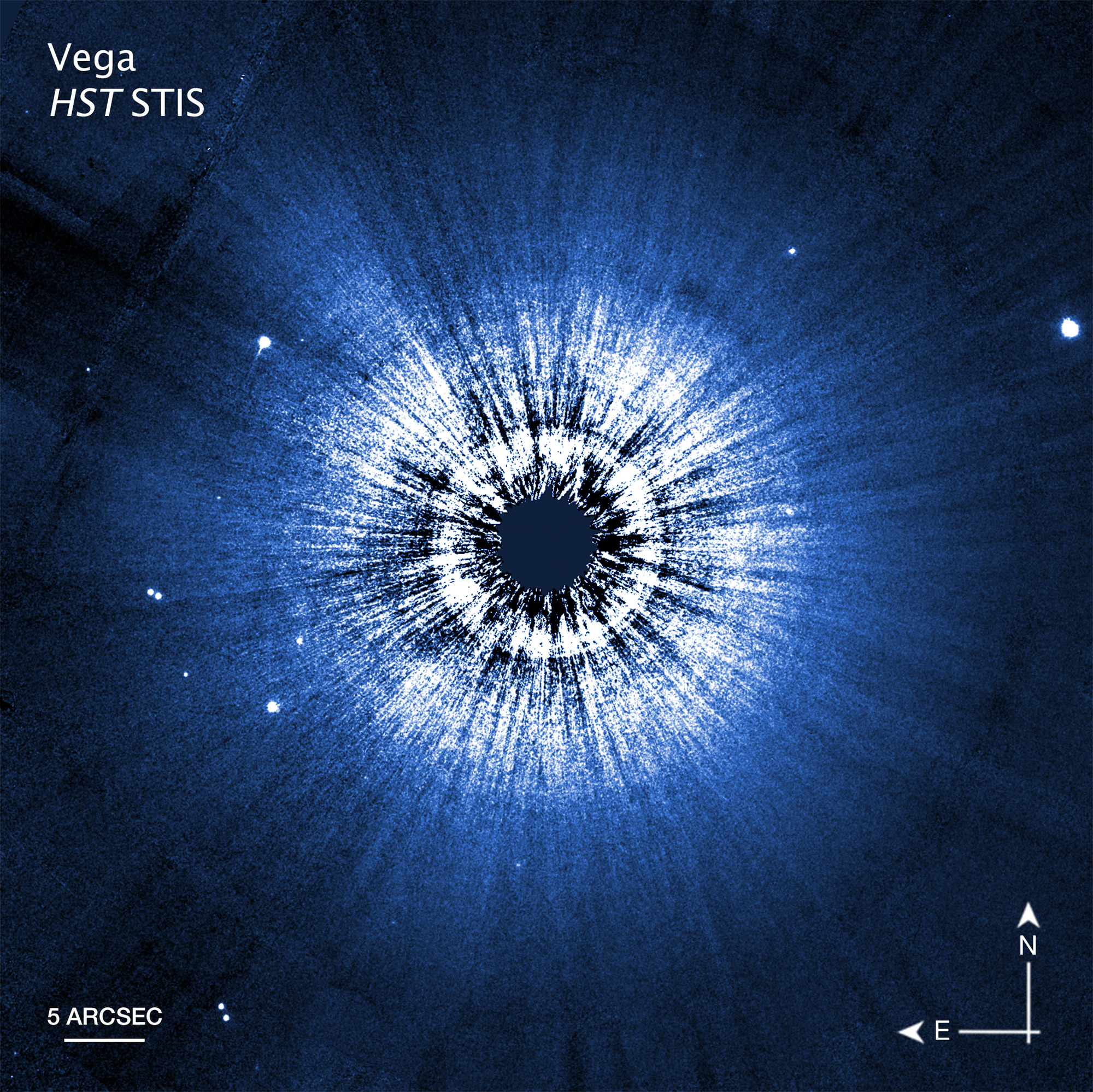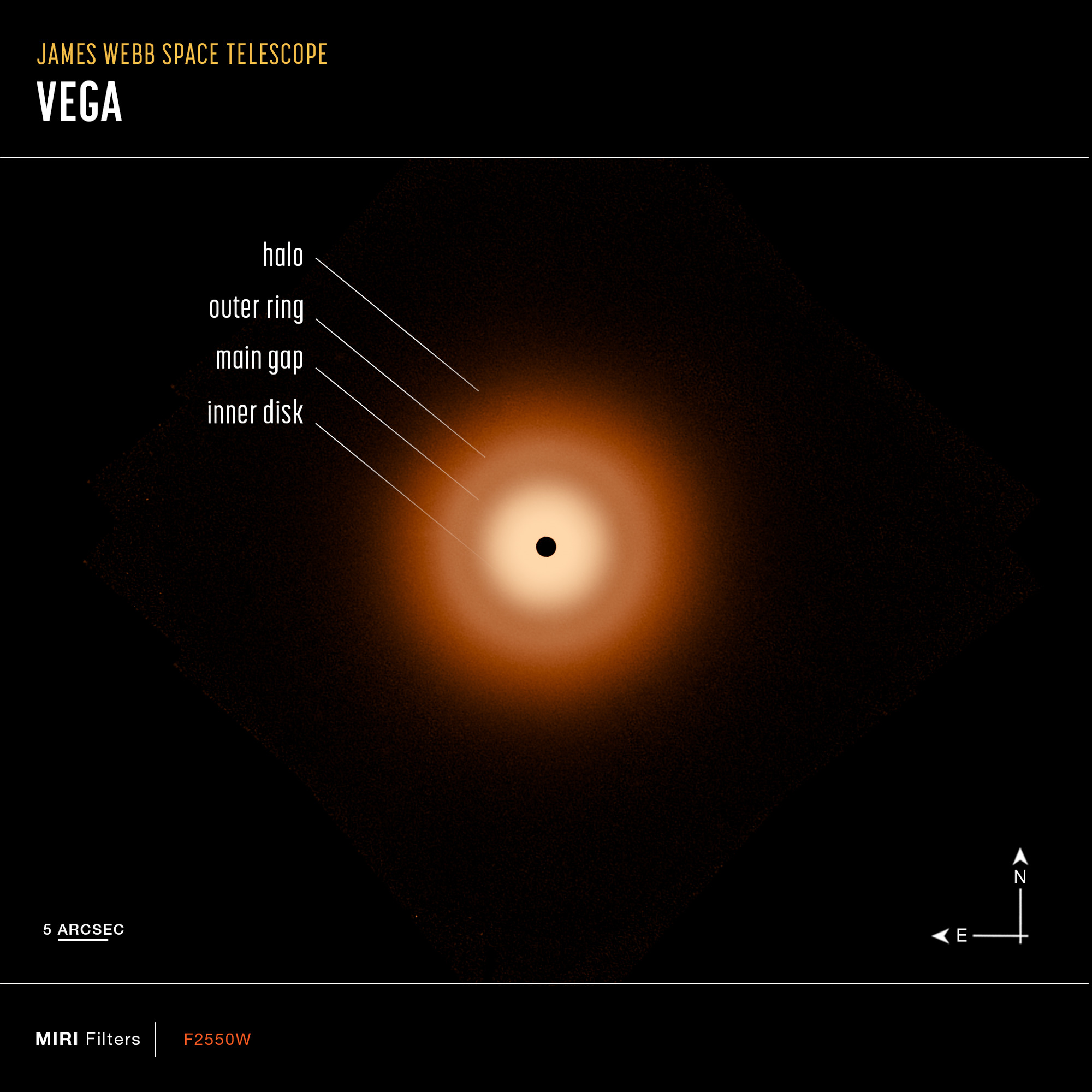'Vega continues to be unusual:' Lack of planets around young star puzzles astronomers
"It's a mysterious system because it's unlike other circumstellar disks we've looked at."

A joint Hubble and James Webb Space Telescope (JWST) project to learn more about the dusty disk around the bright star Vega has found a surprising lack of planets, as evidenced by the disk and surrounding halo being filled with a snow of tiny particles.
In the 1997 movie "Contact," Jodie Foster's character Ellie Arroway is transported to Vega, where she finds a cloud of dust particles but no planets. In Carl Sagan's original 1985 novel, Vega is similarly devoid of planets but is surrounded by dusty rings of debris that might one day form planets. Just like in "Contact," the Hubble Space Telescope and the JWST have found no planets, but contrary to Sagan's story they have shown that Vega's dust disk is actually pretty featureless, with no distinct rings.
However, the new observations are not exhaustive: despite ruling out giant planets larger than Neptune, we cannot yet say whether there are any super-earths or smaller worlds orbiting Vega based on observations of its dusty environs. "It’s making us rethink the range and variety among exoplanet systems,” said Kate Su of the University of Arizona, who led the JWST observations, in a statement.
Vega's circumstellar disk of dust, produced by cascading collisions between asteroids as well as comets shedding dust in their tails, was discovered in 1984 as an excess of infrared light coming from Vega by a joint US–UK–Netherlands mission called IRAS, the Infrared Astronomy Satellite. Interstellar dust is a strong emitter of infrared when it absorbs starlight, is warmed up and re-radiates that light as thermal infrared.
What was remarkable about IRAS' discovery is that it was the first Kuiper Belt-type region found around a star, eight years before the first Kuiper Belt object in our own solar system was discovered.
Because Vega is relatively close to us, at a distance of 25 light years, and presents its dust disk face-on to us, it's one of the best matured dust disks for astronomers to observe, along with the disks around fellow stars Fomalhaut and epsilon Eridani, to which Vega's dust disk is often compared.
Over the years since IRAS other telescopes and missions have followed up on Vega's disk. In 1998 the SCUBA submillimeter instrument of the James Clerk Maxwell Telescope in Hawaii detected the disk, as did the Spitzer Space Telescope in 2005. ALMA, the Atacama Large Millimeter/submillimeter Array in Chile, refined the observations of the ring first detected by IRAS, finding that it begins about 80 astronomical units (AU) from Vega and extends out to about 170 AU. An astronomical unit is defined by the average distance of Earth from the sun, which is 149.6 million kilometers/93 million miles, so IRAS and ALMA measured the dust ring between 12 billion kilometers/7.4 billion miles and 25 billion kilometers/16 billion miles from Vega.
Get the Space.com Newsletter
Breaking space news, the latest updates on rocket launches, skywatching events and more!
However, despite all these observations, details were still scarce. That's why the new observations by the JWST in particular, which has a spatial resolution 8 times greater than Spitzer, are such a big leap.
"Between the Hubble and Webb telescopes, you get this very clear view of Vega," said Andras Gáspár of the University of Arizona. "It's a mysterious system because it’s unlike other circumstellar disks we’ve looked at."
To understand why, consider the dust disk around the star Fomalhaut, which has been regularly observed by Hubble over the years. Fomalhaut's disk has neatly defined rings of dust, carved and shepherded by unseen exoplanets. In comparison, "The Vega disk is smooth, ridiculously smooth," said Gáspár.
Given the similarities between Vega and Fomalhaut – both are A-type stars, both are many times more luminous than the Sun (approximately 40 and 15 times more luminous, respectively) and both are less than a billion years old – why has Fomalhaut seemingly formed large planets that are able to carve the rings in its dust disk, but judging by the Hubble and JWST observations, Vega hasn’t?
"What's the difference? Did the circumstellar environment, or the star itself, create that difference?" asked George Rieke of the University of Arizona. "What's puzzling is that the same physics is at work in both."
Specifically Hubble, employing its Space Telescope Imaging Spectrograph (STIS) coronagraph to block the glare of Vega itself to see the disk, saw scattered light from the disk’s outer halo extending from 80 to 230 AU (34 billion kilometers/21 billion miles). The particles scattering Vega’s light at wavelengths visible to Hubble are no larger than smoke particles, just microns (millionths of a meter) in size.

Meanwhile, the JWST's Mid-Infrared Instrument observed the inner part of Vega’s halo and dust disk, capturing the same Kuiper Belt analog between 80 and 170 AU as previously detected by ALMA and detecting thermal emission from larger particles about the size of sand grains.
"The fact that we're seeing dust particle sizes sorted out can help us understand the underlying dynamics in circumstellar disks," said Schuyler Wolff of the University of Arizona, who led the Hubble observations.

Wolff’s team believes that although there are no large planets evident, there must be a large swarm of asteroids and cometary bodies shedding dust. Light from Vega then is able to push the smaller dust particles out to greater distances and onto elliptical or even hyperbolic orbits, hence why the outer halo is filled with smoke-particle sized grains, and the inner halo with slightly larger grains that can’t be pushed out as far.
The JWST also peered closer to Vega and found that the disk isn’t entirely smooth and featureless. There is a ring at about 60AU (9 billion kilometers/5.6 billion miles) from the star where the brightness drops off. It’s not quite an empty gap – the dip in light varies with wavelength, appearing wider and deeper at longer infrared wavelengths, meaning that it is connected to the size of the grains.
There are two possibilities to explain the feature at 60AU. One is something called the Poynting–Robertson effect, where rather than pushing dust away, light from a star can cause dust grains up to a millimeter in size to slow and begin spiraling towards the star, creating a paucity of particles of that size in that region of the disk where the Poynting–Robertson effect takes hold.
Another possibility is that there is an unseen planet of at least six times the mass of Earth. What is certain is that there are no planets with the mass of Neptune or larger, based on the way the dust in Vega’s disk is distributed.
"The architecture of the Vega system is markedly different from our own solar system where giant planets like Jupiter and Saturn are keeping the dust from spreading the way it does with Vega," said Wolff, adding that "Vega continues to be unusual."
Again, comparisons can be made with Fomalhaut, where the dust is tightly constrained in specific orbits by the gravity of planets.
Neither Hubble nor the JWST can see the dust disk all the way to Vega itself. The JWST's sensitivity to the disk drops off at about 7AU (1 billion kilometers/650 million miles) from Vega, although computer modelling suggests that the inner edge of the disk is somewhere between 3 and 5 AU (449 million kilometers/279 million miles and 748 million kilometers/465 million miles) from Vega. That modelling also suggests that there could be a planet that is carving the sharp inner edge of the disk closest to Vega, but so far no planets at all have been discovered.
"There's still a lot of unknowns in the planet-formation process, and I think these new observations of Vega are going to help constrain models of planet formation," said Su, alluding to how the observations will help to narrow down the different possibilities for those models, bringing us one step closer to fully understanding how planets, including Earth, form.
The results from Hubble and the data from JWST will be published in two individual papers to be presented in The Astrophysical Journal.
Join our Space Forums to keep talking space on the latest missions, night sky and more! And if you have a news tip, correction or comment, let us know at: community@space.com.

Keith Cooper is a freelance science journalist and editor in the United Kingdom, and has a degree in physics and astrophysics from the University of Manchester. He's the author of "The Contact Paradox: Challenging Our Assumptions in the Search for Extraterrestrial Intelligence" (Bloomsbury Sigma, 2020) and has written articles on astronomy, space, physics and astrobiology for a multitude of magazines and websites.
James Webb Space Telescope sees a celestial Venn diagram around a dying star
This star burped after eating a planet — but the planet was really asking for it









